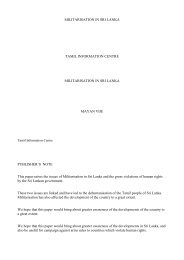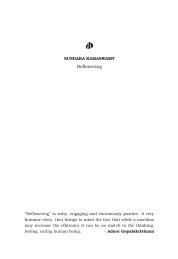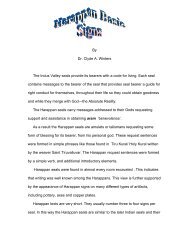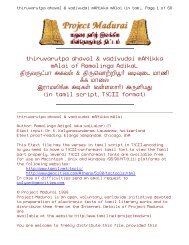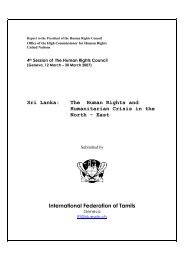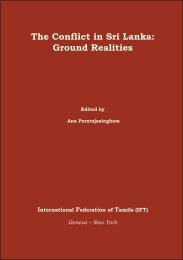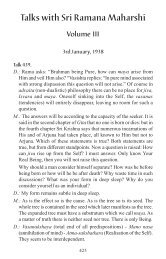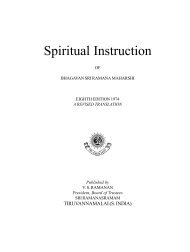Asymmetric Warfare And Low Intensity Maritime Operations
Asymmetric Warfare And Low Intensity Maritime Operations
Asymmetric Warfare And Low Intensity Maritime Operations
- No tags were found...
Create successful ePaper yourself
Turn your PDF publications into a flip-book with our unique Google optimized e-Paper software.
ORF Occasional Paper<strong>Asymmetric</strong> <strong>Warfare</strong> <strong>And</strong> LIMO: Challenges For Indian Navythat cheap, improvised and easy to obtain weapons have been used by suicidal groups tocarry out destruction/damage to high value military targets. These groups also seek totarget naval ships and establishments and other targets in the coastal areas. The Doctrinealso observes that asymmetric actors would use man-portable missiles, explosive-ladenboats, improvised submersibles and divers capable of planting mines and explosives onships. There is also a threat from smuggling, poaching, gun-running along the Indiancoast and distant island territories. Given these threats, the Indian Navy will be involvedin <strong>Low</strong> <strong>Intensity</strong> <strong>Maritime</strong> <strong>Operations</strong>. For such operation the Navy should acquire alarge number of low value petrol ships and be prepared to counter threats covering awide spectrum of threats ranging from high intensity warfare to asymmetric warfare.Besides, the Navy should also be geared to combat piracy in the Indian Ocean and alsoits impact on the merchant shipping that transits through the region.Given these articulations, <strong>Low</strong> <strong>Intensity</strong> <strong>Maritime</strong> <strong>Operations</strong> in the Indian contextsuggests application of force, in the maritime domain, against actors that engagein maritime terrorism, piracy, gun-running, drug smuggling, illegal fishing, poaching,marine pollution and criminal activities at sea that have the potential to disrupt orderat sea. LIMO therefore involves use of force to an extent that it is short of conventionalwar against targets at sea.It is true that asymmetric and non-state actors have developed sophisticated tacticsthat entail attacking ships both in harbour and at sea. Improvised explosive devices,submersibles, mini submarines and high-speed boats are weapons of choice. Off-theshelfcommunication equipment and water sport/diving equipment are part of theirinventories. In the absence of technological superiority over a stronger military, thesegroups have adopted asymmetric strategies and options to challenge maritime forcesand inflict unacceptable costs.Traditional naval missions continue to dominate the minds of naval practitioners butthey now have begun to address multiple forms of conflicts spanning a wide spectrum ofintensity levels ranging from safeguarding sovereignty to protecting the environment interms of marine pollution. Although traditional maritime threats and responses occurin regional crises, more often maritime activity in the next century will focus on newerthreats. These threats require new approaches and new methods. Therefore the newera of conflict at sea demands a freshly articulated maritime strategy based on newlydefined maritime threats.Geostrategic ConsiderationsIndia’s geostrategic sea areas encompass the Arabian Sea and the Bay of Bengal. These arehome to important sea-lanes. A large volume of international long haul maritime cargofrom the Persian Gulf, Africa, Asia Pacific and Europe transits through these waters.They are home to important straits: Hormuz and Malacca. The primary cargo throughthe Hormuz strait is oil/gas, which virtually affects every aspect of the daily lives of mostpeople of the world. Hormuz is fairly deep and vessels of 1,60,000 dead weight tonnagecan pass through the waterway and nearly 15.5 million barrels of oil flows through itdaily. 10 From the Persian Gulf, the sea-lane transits through the Indian Ocean almosthugging the Indian coast towards the Strait of Malacca. Malacca is the busiest with over200 vessels transiting through it everyday. Each day, about 10.3 million barrels are carriedthrough the Strait of Malacca. 11 Virtually all ships destined for East Asia carryingLNG and LPG pass through Malacca and the issue of safety is likely to grow in importanceas East and South East Asia’s energy imports grow. It is estimated that the numberof tankers transiting through Malacca would increase to 59 per day in 2010 from 45 in2000. Similarly, the LPG tanker traffic is expected to increase to seven per day in 2010from five in 2000 and LNG are expected to rise to 12 per day from eight in 2000. 12According to military experts, future conflicts will take place in the littorals i.e. wheresea meets the land. 13 A large proportion of the world population is located in the littoral.Besides, much of the industrial infrastructure and wealth are concentrated in these areas.Coastal regions serve as the nodes for transport of trade, culture, as also the hub ofillegal activity, be it contraband trade, drug smuggling, gun-running and even humansmuggling. The sea serves as an easy highway and acts as a catalyst for promoting suchactivities. A quick look at the geography of the Indian Ocean region indicates that terroristhubs are located in the littoral: LTTE in Jaffna, Sri Lanka, 14 Al Qaeda in Yemen,Somalia, Pakistan, Bangladesh 15 and Indonesia and Jemaah Islamiyah 16 and Free AcehMovement in Indonesia. Some of these are also home to pirates. The centre of gravityof piracy and terrorism at sea is currently located in the Indian Ocean region. Thisis further flavored with the Golden Crescent and the Golden Triangle, hubs for drugsmuggling and gun-running.Terrorism at SeaThreat of terrorism to maritime security is not a new phenomenon. In the past therehave been several instances when ships have been taken over by insurgents or attackedby terrorists. 17 1988 can be termed as a seminal year heralding the modern age of maritimeterrorism. 18 Terrorists attacked City of Poros, a Greek cruise ferry carrying 500tourists. 19 But it was the Achille Lauro incident that caught the attention of the internationalcommunity with regard to the menace of terrorism at sea and the formulationof an international convention under the United Nations. 20 Similarly, on November3, 1988, two trawlers carrying 150 PLOTE (People’s Liberation Organisation of Tamil7www.orfonline.orgwww.orfonline.org 8



